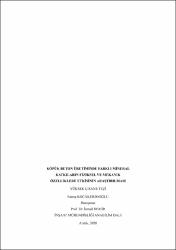| dc.contributor.advisor | Demir, İsmail | |
| dc.contributor.author | Kocakerimoğlu, Fatma | |
| dc.date.accessioned | 2021-02-22T07:57:39Z | |
| dc.date.available | 2021-02-22T07:57:39Z | |
| dc.date.issued | 2019 | en_US |
| dc.identifier.uri | https://hdl.handle.net/11630/8553 | |
| dc.description.abstract | Fiziksel, mekanik ve termal özellikleri nedeniyle köpük beton günümüzde inşaat sektöründe giderek artan bir ilgiye sahip olmuştur. Bu alandaki teknolojik gelişmeler köpük beton üretimine ve yaygınlaşmasına önemli katkı sağlamıştır. Normal beton 2300 kg/m3 birim hacim ağırlığı ile yapılar üzerinde önemli ölü yükler meydana getirir. Köpük beton 300- 1800 kg/m3 aralığında üretilebilmektedir. Köpük beton gazbeton ürünlerin benzeri olup köpük katkısı ile gözenek oluşturulur. Köpük beton diğer yapı malzemelerine göre daha ekonomik olup kolay ve hızlı üretim gibi avantajlara sahiptir. Köpük beton düşük basınç dayanımına karşı ısı ve ses yalıtımı performansı yüksektir. Günümüzde çevreye duyarlı ve sürdürülebilir yapılar inşa etmek ana hedeflerden biridir. Köpük beton üretiminde atık mineral katkılar kullanılarak çevreci ve sürdürülebilir malzeme üretimine imkan sağlamaktadır.
Bu çalışmada köpük beton üretiminde CEM I 42,5 Portland Çimentosu kullanılmıştır. Çalışmada sentetik esaslı köpük ajanı kullanılmıştır. Karşılaştırmalı sonuçlar elde etmek amacı ile mineral katkılar olarak doğal kum, uçucu kül ve genleştirilmiş perlit kullanılmıştır. Çalışmada kullanılan hammaddelerin karekterizasyonu yapılarak belirlenmiştir. Karışım suyunu azaltmak ve akışkanlığı artırmak amacı ile polikarboksilik esaslı akışkanlaştırıcı/priz hızlandırıcı katkı kullanılmıştır. Alkali aktivatör olarak NaOH ve priz süresini kısaltarak hidratasyonu hızlandırmak amacı ile CaCl2 belli oranlarda karışıma ilave edilmiştir. Oluşabilecek rötre çatlaklarını engellemek amacı ile polipropilen lif kullanılmıştır. Köpük beton örneklerin üretiminde ön köpük yöntemi uygulanmıştır. Bu yöntemde önce istenen yoğunlukta köpük üretilerek, akıcı kıvamda hazırlanan harca ilave dilmektedir.
Köpük beton örnekler 460-630 kg/m3 arasında üretilmiştir. Örnekler 60 0C’ sıcaklıkta atmosferik buhar kürü uygulanarak mukavemet kazanmaları sağlanmıştır. Köpük beton örnekler üzerinde fiziksel, mekanik testler ve mikro yapı analizleri yürütülerek incelenmiştir. Genleşmiş perlit katkılı köpük beton örneklerde diğer karışımlara göre daha düşük ısı iletim değerleri elde edilmiştir. Doğal kum kullanılan örneklere göre uçucu kül katkılı örneklerin mekanik özellikleri daha yüksek performans göstermiştir. | en_US |
| dc.description.abstract | Due to its physical, mechanical and thermal properties, foam concrete has become increasingly interested in the construction industry today. Technological developments in this field have contributed significantly to the production and spread of foam concrete. Normal concrete has a unit volume weight of 2300 kg/m3 and creates significant dead loads on structures. Foam concrete can be produced in the range of 300- 1800 kg/m3. Foam concrete is similar to aerated concrete products and pore is formed with the foam additive. Foam concrete is more economical than other building materials and has advantages such as easy and fast production. Foam concrete has high thermal and sound insulation performance against low pressure resistance. Today, building environmentally friendly and sustainable buildings is one of the main goals. It enables the production of environmentally friendly and sustainable materials by using waste mineral additives in foam concrete production.
In this study, CEM I 42,5 Portland cement was used in the production of foam concrete. Synthetic based foaming agent was used in the study. Natural sand, fly ash and expanded perlite were used as mineral additives to obtain comparative results. The raw materials used in the study were characterised of determined by performing. Polycarboxylic based super plasticizer/set accelerator additive has been used to reduce the mixing water and increase fluidity. NaOH was used as an alkaline activator, CaCl2 was added to the mixture in certain proportions in order to accelerate hydration by shortening the setting time. Polypropylene fibre was used to prevent shrinkage cracks that may occur. The pre-foam method was used in the production of foam concrete samples. In this method, foam of the desired density is produced first and added to the mortar prepared in a fluid consistency.
Foam concrete samples were produced between 460-630 kg/m3. The samples gained strength by applying atmospheric steam cure at 60 0C. Physical and mechanical tests and microstructure analyses were carried out on foam concrete samples and examined. Lower heat conduction values were obtained in foam concrete samples with expanded perlite compared to other mixtures. Mechanical properties of fly ash added samples showed higher performance than natural sand samples. | en_US |
| dc.language.iso | tur | en_US |
| dc.rights | info:eu-repo/semantics/openAccess | en_US |
| dc.subject | Köpük beton | en_US |
| dc.subject | Uçucu kül | en_US |
| dc.subject | Genleşmiş perlit | en_US |
| dc.subject | Kum | en_US |
| dc.subject | Elyaf | en_US |
| dc.subject | Beton katkıları | en_US |
| dc.title | Köpük beton üretiminde farklı mineral katkıların fiziksel ve mekanik özelliklere etkisinin araştırılması | en_US |
| dc.title.alternative | Investigation of the effects of different mineral admixtures admixtures on physical and mechanical properties in foam concrete production | en_US |
| dc.type | masterThesis | en_US |
| dc.department | Mühendislik Fakültesi | en_US |
| dc.identifier.startpage | 1 | en_US |
| dc.identifier.endpage | 104 | en_US |
| dc.relation.publicationcategory | Tez | en_US |
| dc.contributor.institutionauthor | Kocakerimoğlu, Fatma | |



















